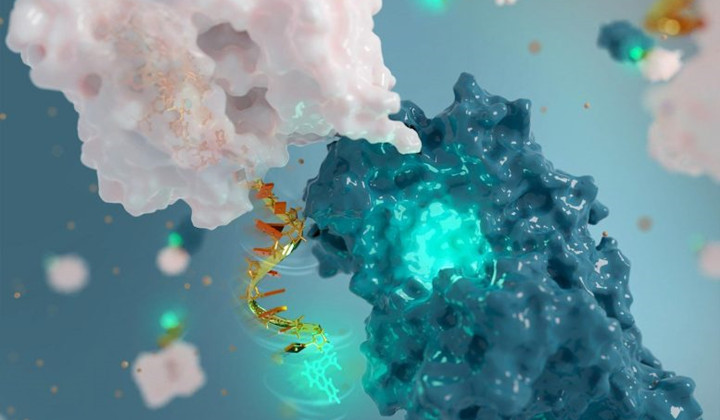


Researchers at Université de Montréal have created a nanoantenna to monitor the motions of proteins. Reported last week in Nature Methods, the device is a new method to monitor the structural change of proteins over time – and may go a long way to helping scientists better understand natural and human-designed nanotechnologies.
“The results are so exciting that we are currently working on setting up a start-up company to commercialize and make this nanoantenna available to most researchers and the pharmaceutical industry,” said UdeM chemistry professor Alexis Vallée-Bélisle, the study’s senior author.
An antenna that works like a two-way radio
Over 40 years ago, researchers invented the first DNA synthesizer to create molecules that encode genetic information. “In recent years, chemists have realized that DNA can also be employed to build a variety of nanostructures and nanomachines”, added the researcher, who also holds the Canada Research Chair in Bioengineering and Bionanotechnology.
“Inspired by the ‘Lego-like’ properties of DNA, with building blocks that are typically 20,000 times smaller than a human hair, we have created a DNA-based fluorescent nanoantenna, that can help characterize the function of proteins.” he said
“Like a two-way radio that can both receive and transmit radio waves, the fluorescent nanoantenna receives light in one color, or wavelength, and depending on the protein movement it senses, then transmits light back in another color, which we can detect.”
One of the main innovations of these nanoantennae is that the receiver part of the antenna is also employed to sense the molecular surface of the protein studied via molecular interaction.
One of the main advantages of using DNA to engineer these nanoantennas is that DNA chemistry is relatively simple and programmable,” said Scott Harroun, an UdeM doctoral student in chemistry and the study’s first author.
“The DNA-based nanoantennas can be synthesized with different lengths and flexibilities to optimize their function,” he said. “One can easily attach a fluorescent molecule to the DNA, and then attach this fluorescent nanoantenna to a biological nanomachine, such as an enzyme.
“By carefully tuning the nanoantenna design, we have created five nanometer-long antenna that produces a distinct signal when the protein is performing its biological function.”
Fluorescent nanoantennas open many exciting avenues in biochemistry and nanotechnology, the scientists believe.
“For example, we were able to detect, in real time and for the first time, the function of the enzyme alkaline phosphatase with a variety of biological molecules and drugs,” said Harroun. “This enzyme has been implicated in many diseases, including various cancers and intestinal inflammation.
“In addition to helping us understand how natural nanomachines function or malfunction, consequently leading to disease, this new method can also help chemists identify promising new drugs as well as guide nanoengineers to develop improved nanomachines,” added Dominic Lauzon, a co-author of the study doing his PhD in chemistry at UdeM.
One main advance enabled by these nanoantennas is also their ease-of-use, the scientists said.
“Perhaps what we are most excited by is the realization that many labs around the world, equipped with a conventional spectrofluorometer, could readily employ these nanoantennas to study their favorite protein, such as to identify new drugs or to develop new nanotechnologies,” said Vallée-Bélisle.
Reference: “Monitoring protein conformational change using fluorescent nanoantennas” by Scott G. Harroun, Dominic Lauzon, Maximilian C. C. J. C. Ebert, Arnaud Desrosiers, Xiaomeng Wang and Alexis Vallée-Bélisle, 30 December 2021, Nature Methods.
DOI: 10.1038/s41592-021-01355-5
Funding was provided by the Natural Sciences and Engineering Research Council of Canada; the Fonds de recherche du Québec – Nature et technologies; Canada Research Chairs; the Quebec Network for Research on Protein Function, Engineering, and Applications; and Université de Montréal.
Source: https://scitechdaily.com/chemists-use-dna-to-build-the-worlds-tiniest-antenna-like-a-two-way-radio/

Scheduled Server Maintenance and System Downtime Notice Dec 16, 2025

Celebrating CM Editorial Board Members Recognized in the Wor... Oct 10, 2025

Food Science and Engineering Now Indexed in CAS Database Aug 20, 2025

Contemporary Mathematics Achieves Significant Milestone in 2... Jun 19, 2025

Three Journals under Universal Wiser Publisher are Newly Ind... Apr 21, 2025